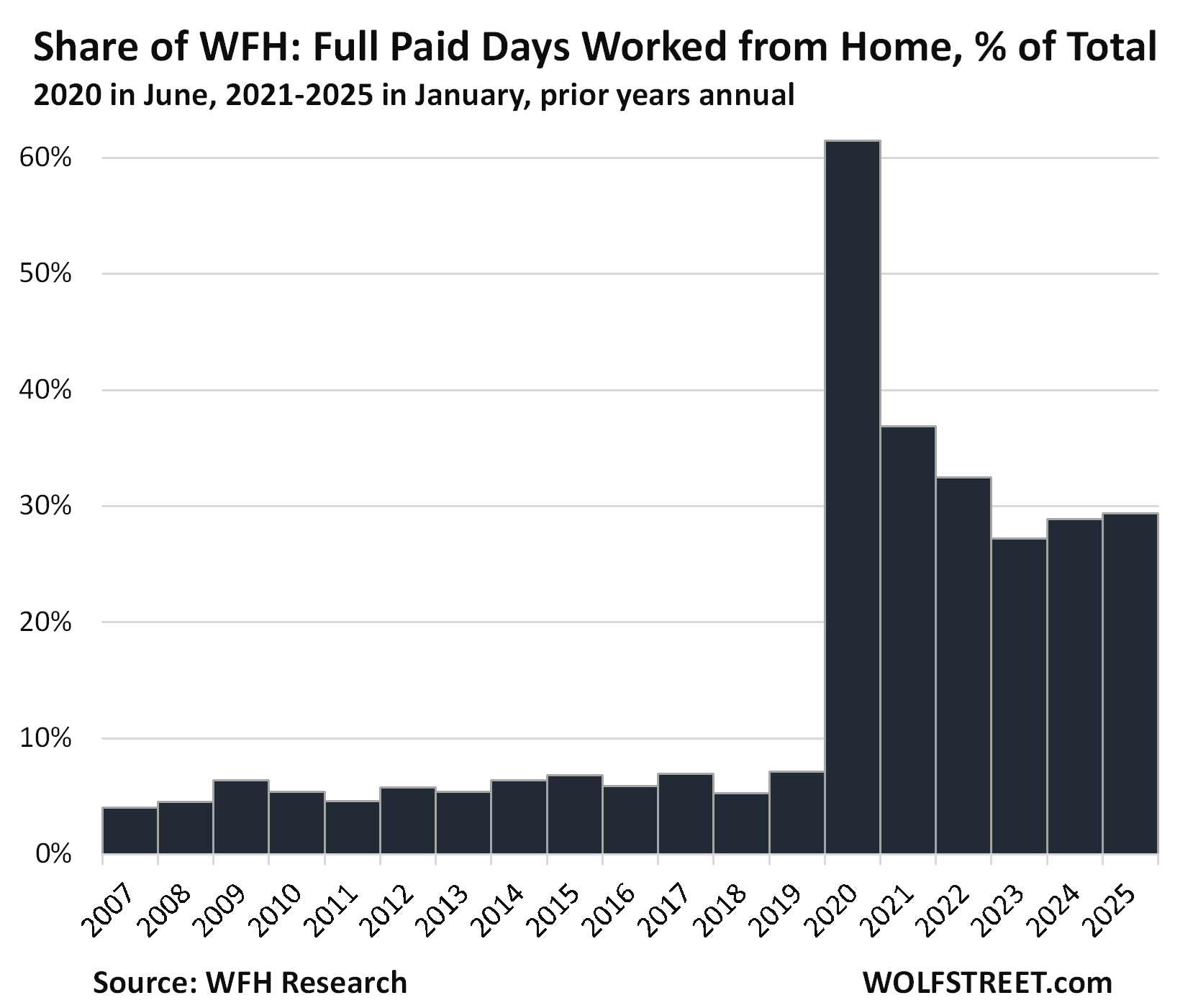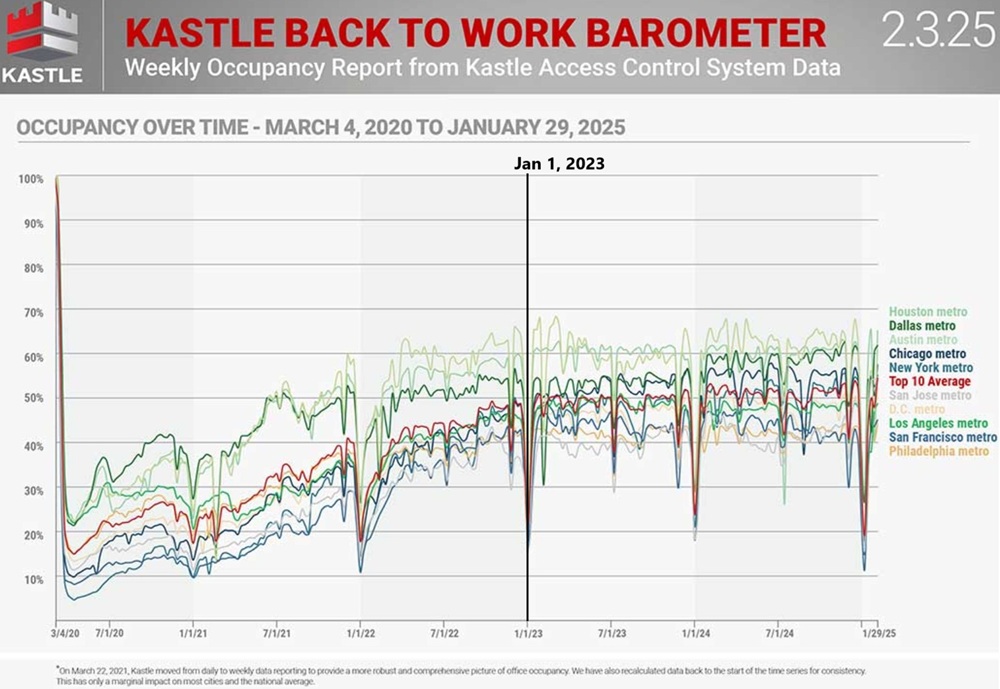
Hopes that Return to Office will bail out the office sector of CRE seem premature: Data on office attendance and Working from Home.
By Wolf Richter for WOLF STREET.
The good folks in commercial real estate, including institutional investors, have been saying for over a year that the Return-to-Office mandates will scuttle Working-from-Home and fill up office space and boost the office sector out of its epic depression.
The media have jumped all over it with breathtaking headlines every time a company mandated a full five-days-a-week RTO, and enough companies have done so to keep these stories percolating, such as Tesla in 2022 already, then Amazon, Goldman Sachs, J.P. Morgan, Morgan Stanley, X, Dell, etc. Lots of times, these in-office policies come with the explicit or implicit threat of “or else.” And the Trump White House has been in the news with its battle trying to force it to happen with whoever will be left working for the government.
But those media reports may be giving the wrong impression, and in fact very little has changed since the beginning of 2023 in terms of actual office attendance and the percentage of full paid days worked from home – which is what should matter to the CRE industry, rather than the breathless media reports. So we’ll at these two data sets.
Office attendance has barely ticked up in two years.
Kastle’s weekly back-to-work barometer – which tracks how many people enter an office building for which Kastle provides the electronic access system – has barely ticked up since the start of 2023. Its weekly barometer measures office occupancy as a percentage of what it had been before Covid. So if pre-Covid levels of office occupancy come back, the barometer would rise to 100%, meaning same occupancy as before Covid, the good old days, so to speak.
But far from it. The average occupancy in the top 10 office markets in the latest week was still only at 54% of where it had been before Covid, so still down by 46% from pre-Covid, and only a few percentage points higher of where it had been at the same time in 2023, and just a hair higher than at the same time in 2024.
In the chart, the top gridline = 100% = pre-Covid level. The 10-city weekly average (red line) has been around 50% since the beginning of 2023, sometimes over, sometimes under. During the latest week, it was 54%, with Houston being at 65% at the top end and Philadelphia being at 44% at the bottom. The epicenter of WFH, San Francisco, was at 45% (chart from Kastle, click on the chart to enlarge it):
The prevalence for hybrid work shows up in the huge difference between the days of the week with the lowest occupancy, which for the month of January was Friday, with an average occupancy rate of 37% of pre-Covid levels, according to Kastle. The day of the week with the highest occupancy rate was Tuesday at 63%.
The average occupancy on Fridays in January was 28% in San Francisco and 30% in New York City. Even at the high end, in Houston, it was only 48%.
No decline in the share of WFH in 2023-2025.
Another data set shows the same principle from a different angle: The share of full paid days worked from home had spiked by mid-2020 to over 60%, in part because companies with office workers switched to WFH, and in part because other employment that could not be shifted to WFH, such as in accommodation and food services, collapsed. During that time, tech workers switched to full WFH and kept their jobs, while restaurants and hotel workers weren’t working at all.
But as the economy reopened, those service workers were called back, and the share of WFH as a percent of overall full paid days plunged. But for office workers, WFH has remained a big factor. As a result, the share of full paid days worked from home remains at far higher levels than before Covid and has not come down further in 2023, 2024, and in January 2025.
This according to the ongoing study and data collection by Jose Maria Barrero, Nicholas Bloom, Shelby Buckman, and Steven J. Davis, published by WFH Research (based on the original paper: Barrero, Jose Maria, Nicholas Bloom, and Steven J. Davis, 2021. “Why working from home will stick,” National Bureau of Economic Research Working Paper 28731).
In January 2025, over 29% of all full paid days were worked from home, up a hair from the Januarys in 2023 and 2024.
So the share of WFH has given up about half of the Covid spike (which peaked in June 2020 at 62%) and then got stuck at a share that is roughly four times higher than it had been in 2019 (7%). While the author say that they may over-sample people who are “more tech and internet savvy, especially among the least educated,” the trend still works out about the same.

Of all full-time employees, 13% were full WFH in late 2024, while 26% were in a hybrid-WFH situation, so about 39% were at partially or fully WFH, according to the study. The remaining 61% were working fully on site.
WFH and hybrid arrangements dominated in these six industries, particularly in Information, which includes a lot of tech and social media companies, where only 28% of the full-time employees worked fully on site.
Percentage of full-time employees working fully on site, in a hybrid situation, or full WFH:
- Information: 28% fully on site, 51% hybrid, 21% full WFH,
- Finance & Insurance: 33% fully on site, 40% hybrid, 27% full WFH
- Wholesale trade: 44% fully on site, 40% hybrid, 15% full WFH
- Professional & business services: 45% fully on site, 30% hybrid, 24% full WFH
- Utilities: 49% fully on site, 28% hybrid, 23% full WFH
- Real estate: 49% fully on site, 40% hybrid, 11% full WFH
Hopes that RTO will bail out the office sector seem premature.
Turns out, many companies have stuck with hybrid work, often involving hot-desking, hoteling, and other arrangements, such as Google (3 days a week in office), Microsoft (50% of the time), Apple (3 days), Starbucks office workers (3 days), Adobe (2-3 days), Meta (1-2 days), etc., though they’re enforcing those days in the office more strictly, including on an “or-else” basis. Countless smaller companies have moved into the same direction.
And many many other companies, including Nvidia, Airbnb, Coinbase, Drobox, etc., and lots of smaller companies, startups, etc., whose employment is growing rapidly, have no RTO mandate at all. They have finetuned their WFH policies, created meeting places, and made lots of other adjustments to make remote work productive. For the company, it saves on office expenses, and it makes hiring good talent easier since WFH remains immensely popular. And it seems to be working for them.
But the media don’t write breathless headlines about companies’ sticking to and refining their WFH policies. These companies dedicated to WFH just don’t get that kind of screaming attention. And these companies wouldn’t do it if it didn’t work for them. So these hopes in the CRE industry that RTO will somehow refill offices and bail out the office sector seem premature.
Enjoy reading WOLF STREET and want to support it? You can donate. I appreciate it immensely. Click on the beer and iced-tea mug to find out how:
Would you like to be notified via email when WOLF STREET publishes a new article? Sign up here.
![]()
Energy News Beat


